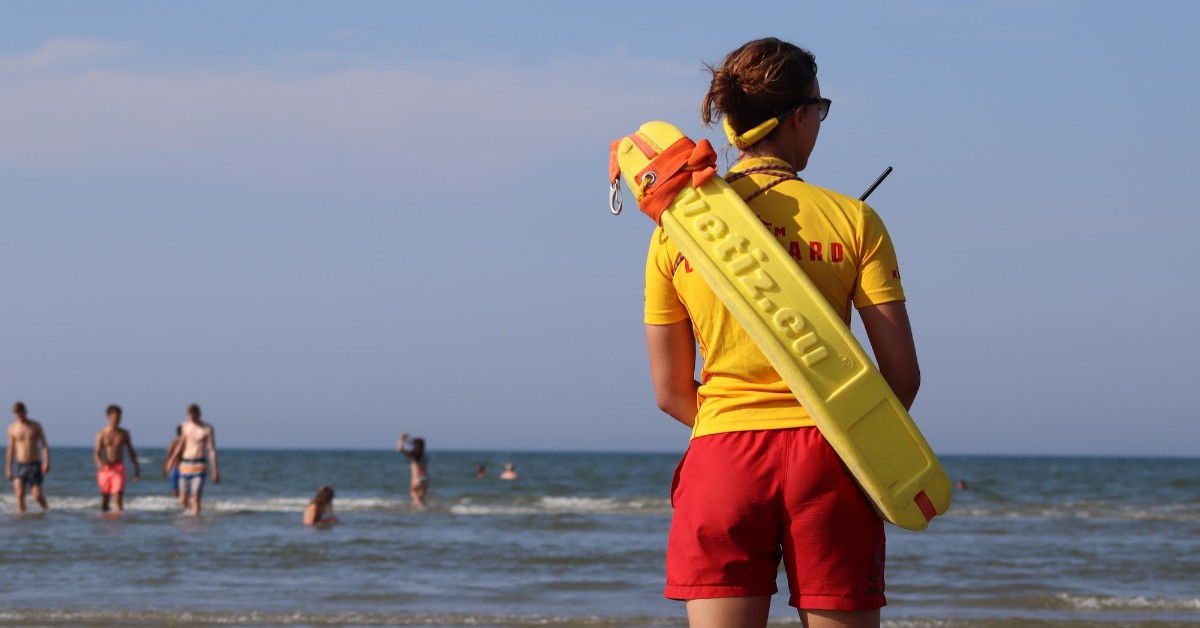How to Become a Lifeguard (The Ultimate Guide 2023)

How to Become a Lifeguard: People’s safety and well-being are the responsibility of lifeguards at beaches, waterparks, and swimming pools all around the world.
Some people work as lifeguards as after-school employment, while others do so as their full-time profession. Whatever your motivation, you must prepare your body, acquire the essential lifesaving abilities, and then look for work as a lifeguard.

How to Become a Lifeguard: FAQs & Answers
What qualifications do I need to become a lifeguard?
The qualifications needed to become a lifeguard may vary depending on your location, but generally, you will need to have a certification in lifeguarding, CPR, first aid, and water safety. Additionally, you may need to complete a swim test to demonstrate your swimming ability.
How can I get certified as a lifeguard?
You can get certified as a lifeguard by completing a lifeguard training course from an accredited organization such as the American Red Cross or the YMCA. These courses typically include training in lifeguarding techniques, CPR, first aid, and water safety.
Is there an age requirement to become a lifeguard?
The age requirement to become a lifeguard may vary depending on your location, but generally, you must be at least 15 years old to become a lifeguard.
What kind of physical fitness do I need to become a lifeguard?
As a lifeguard, you will need to be physically fit and able to swim long distances and perform rescues in the water. You should also have good endurance, strength, and flexibility.
What kind of training do lifeguards receive?
Lifeguards receive training in a variety of areas, including lifeguarding techniques, CPR, first aid, water safety, and communication skills. They may also receive additional training in rescue techniques, teamwork, and emergency response.
How much does lifeguard training cost?
The cost of lifeguard training may vary depending on the organization providing the training, but it typically ranges from $150 to $300.
What kind of job opportunities are available for lifeguards?
Lifeguards can find job opportunities at a variety of locations, including public and private pools, beaches, water parks, and community centers. They may also work as swim instructors or coaches.
How to Become a Lifeguard
a. Developing Physical Fitness
1. Get in shape
A competent lifeguard must be physically fit. You should be in decent physical condition. The 10/20 rule is followed by lifeguards. It is important for lifeguards to be in condition and strong swimmers since they have just ten seconds to react once they spot a possible hazard and twenty seconds to get to the individual.
2. Swim for fitness
Before working as a lifeguard, you must be an excellent swimmer. To strengthen your legs, kickboard while swimming. You must pass a timed swim test in order to advance in any certification programmes.
- To ensure that your technique is sound, enroll in a swimming lesson with a qualified instructor.
- Practice various swimming strokes, such as the freestyle, backstroke, or breaststroke. You may strengthen your swimming by using different swimming techniques, which will work out different muscles.
3. Run to strengthen your cardiovascular system
Long swimming sessions call for this. If you can, jog on the sand. Running on sand is more challenging and hence more effective than running on concrete or grass. Some claim that it’s healthy for your joints as well.
- You will be more prepared for a lifeguard job at the beach if you run on the sand.
- To increase the strength in your lower body, run upstairs or in stadiums. You need powerful legs to assist you to go through the water and swim as quickly as you can.
4. Boost your upper body and core strength
A few seconds can sometimes be the difference between life and death. To save people more quickly, have powerful arms.
- To strengthen your arms and upper body, perform pull-ups, dips, bench presses, and curls. Carrying victims back to safety requires a lot of upper body power.
- To build up your abs, try doing sit-ups. Your entire body should be in good shape. You will go through the water more quickly if you have a stronger and leaner torso.
5. Learn to hold your breath to expand your lung capacity
The individual you are seeking to help could occasionally be trapped, deep underground, or otherwise challenging to reach the surface. You must be able to hold your breath for a lengthy time in this situation.
6. Eat well and drink plenty of water
This is crucial for your training, but it’s also necessary if you start a job that involves spending a lot of time outside. Your body will quickly lose important nutrients if you sweat. Always have a water bottle close by hand.
b. Getting certified
1. Locate a life-guarding class in your region
The YMCA and the regional Red Cross district organization both provide certain lifeguard training courses. Starfish Aquatics Institute and NASCO both provide additional credentials that are recognized across the nation. Consider visiting the Lifesaving Society if you are a Canadian. Some high schools provide swimming programmes in gym classes that include incorporating CPR training.
- Depending on where you wish to work as a lifeguard, pick a training programme. For lifeguarding in a lake, beach, water park, and indoor pool, different courses are often available.
- Classes typically last six weeks. A 3-day crash course is available for Ellis and Associates.
2. Study first aid and CPR
You’ll need to finish CPR and first aid training before applying to the majority of these programmes. It is advisable to learn CPR techniques before registering for a course. Get experience beforehand so that you may use the programme as a review.
3. Recognize warning indicators
Lifeguards frequently spot warning indications that someone will require their assistance before a disaster arises. Well-versed lifeguards have the option of being watchful or taking preventative measures. Some of the most typical red flags include:
- Poor swimmers can be seen regularly bobbing their heads in and out of the water, pulling themselves along the edge of the pool with their hands, or clinging to flotation devices out of fear.
- Swimmers who frequently seek for assistance from others, wildly wave their arms or otherwise appear to be in distress are the most evident warning indicators.
- Often, drowning starts out with no warning or resistance. Keep an eye out for those who fall into the sea and do not surface.
4. Experiment with using life-saving tools
In addition to using their bodies, lifeguards have a variety of gear at their disposal to aid in saving drowning swimmers.
- To keep individuals afloat, lifeguards employ flotation aids, including rescue tubes, rescue buoys, and ring buoys. In addition, lifeguards have access to medical supplies, including resuscitation and defibrillator devices, that are often found in ambulances and hospitals. In addition, lifeguards are equipped with spinal boards for moving persons who may have suffered spinal injuries, as well as basic first aid supplies with bandages for cuts and scratches.
- Face shields and pocket masks are barriers used by lifeguards. During CPR, they are put over the victim’s lips to stop the spread of contagious illnesses through body fluids.
5. Recall common safety procedures
Although each beach, waterpark, or pool has its own set of safety rules, there are several universally applicable fundamental ones, such as:
- Swim only when there is a lifeguard on duty.
- There should be no rough play or rushing close to the water.
- Take hygiene precautions, such as providing babies with waterproof diapers.
- Don’t swim if you have open wounds.
- Glass containers should not be used for drinking in or near water.
- Avoid using drugs or drinking a lot of alcohol before going swimming.
- When it rains, stay out of the water.
6. Find out about wildlife, water quality, and tides. Only if you intend to work as a lifeguard at a beach is this vital
One of the riskiest swimming conditions for beginners is a riptide. Swimmers are dragged away from the beach by riptides, also known as rip currents, at speeds that are too fast for even seasoned Olympic swimmers. The secret is to swim perpendicular to the coast until you can get away from the riptide.
At the beach, shore breakers may be a major menace. They may be unexpected, knock people down, and result in catastrophic neck and spinal injuries when waves crash too close to the coast. Even seasoned beachgoers occasionally are caught off guard.
Red tide has a significant impact on swimming conditions as well. Certain colonies of algae, referred known as blooms, consistently produce an excessive amount of toxins. Red tide is caused by the buildup of these poisons. Red tide may harm marine life and sicken people seriously.
7. Ace certification exams
At the conclusion of your training, you will take a number of examinations that assess both your written knowledge of the aforementioned subjects and your physical capability to carry out the duties of a lifeguard.
- You’ll be put through a series of tests that include things like crowd control, victim assessment, neck, spinal, and head injury first aid, CPR methods, and basic swimming safety procedures.
- Depending on where you take the certification examinations, there are various physical assessments. Others call for you to swim 300 yards, tread water unassisted for two minutes, use a variety of swimming strokes, surface dive to a depth of 7 to 10 feet (2.1 to 3.0 m), and hold your breath for one to two minutes.
- Ensure that all of your certificates are current. One to five years are the typical certification terms. It would be challenging to work as a lifeguard if your certification becomes invalid.
Conclusion
Becoming a lifeguard can be a fulfilling and rewarding career for those who enjoy swimming and helping others. To become a lifeguard, you will need to obtain certification in lifeguarding, CPR, first aid, and water safety. Additionally, you should be physically fit and able to perform rescues in the water.
Training courses are available from accredited organizations, and job opportunities can be found at various locations such as pools, beaches, water parks, and community centers. The cost of lifeguard training may vary depending on the organization providing the training, but it typically ranges from $150 to $300. Overall, becoming a lifeguard can be a great opportunity for those who are passionate about water safety and saving lives.
That is it on how to become a lifeguard.
Recommended:
You may want to check out the following related articles.
How to Become a Pilot (Steps and Requirements)
How to Become a Notary in Your State (2023 Guide)
11 Tips to Help You Avoid Emotional Driving (2023 Guide)



